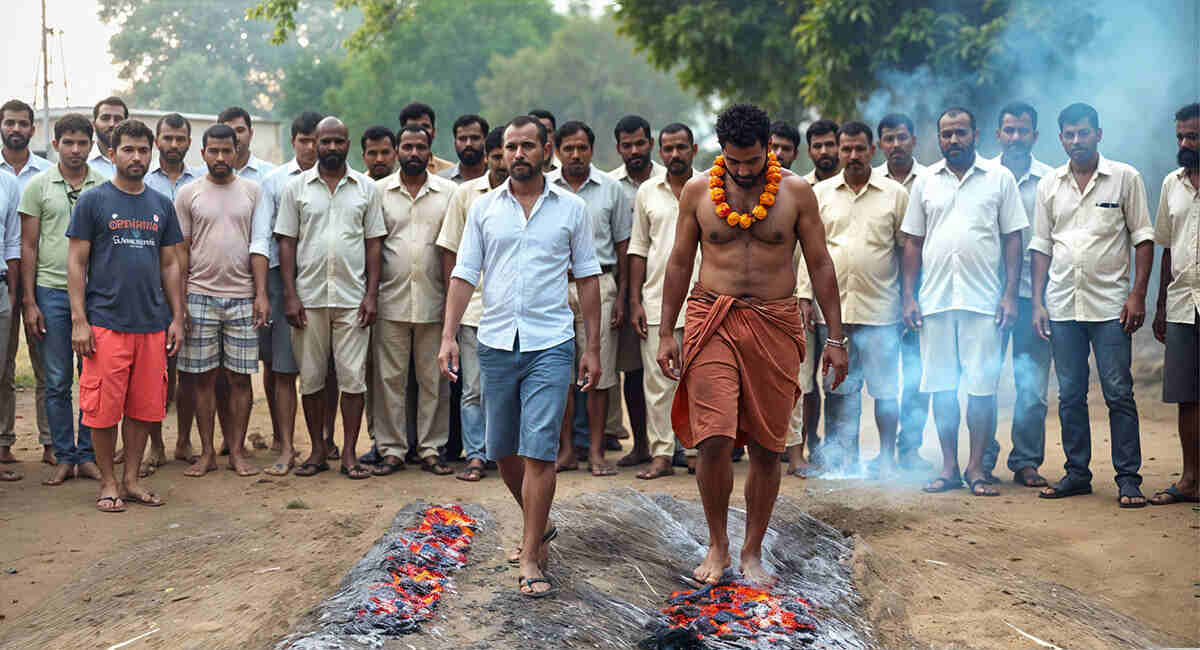Jhamu Yatra: The Fiery Walk of Devotees in Odisha
India’s cultural fabric is elaborately woven with numerous festivals, each telling a tale of devotion, history, and fervor. Among these, Jhamu Yatra, a stunning spectacle of religious zeal and physical endurance, stands out as one of Odisha’s most intense and awe-inspiring festivals. Celebrated primarily in April during the Hindu month of Chaitra, this fiery ritual honors Goddess Maa Mangala, particularly in the town of Kakatpur, in the Puri district of Odisha.
Let’s take a deeper look into the Jhamu Yatra, where fire becomes a medium of divine connection, and barefooted devotees walk across burning embers to express gratitude, seek blessings, or fulfill vows.
The Significance of Jhamu Yatra
The Jhamu Yatra is more than just a festival; it is a profoundly spiritual observance and a public demonstration of faith. The central figure of reverence is Maa Mangala, a powerful manifestation of Shakti, the divine feminine energy. Devotees believe she is a healer, protector, and granter of wishes.
The festival reflects the belief that with Maa Mangala’s blessings, devotees can walk across fire without experiencing pain or injury. The ritual, therefore, becomes a symbol of divine protection, penance, and unwavering devotion.
Where and When Is It Celebrated?
The most famous celebration of Jhamu Yatra takes place at Maa Mangala Temple in Kakatpur. Other parts of Odisha, including Cuttack, Bhadrak, and Khurda, also observe similar versions of the festival.
The festival is held in the month of Chaitra, usually during April, culminating on the Chaitra Purnima (full moon). It coincides with Chaiti festivals and includes fire-walking rituals, community worship, and cultural performances. The main event typically takes place in the evening or at night, adding to the intensity and mystique of the fiery ritual.
The Ritual: Walking Through Fire
The core of Jhamu Yatra is the fire-walking ceremony. Devotees, known as Jhamu Yatris or Bhaktas, prepare for this day through fasting, abstinence, and spiritual discipline. They often dress in saffron robes, smear their bodies with ash, and chant the name of Maa Mangala with unwavering faith.
Steps in the Ritual Include:
- Preparation of the Fire Pit: A long stretch of the road or temple ground is filled with burning embers or firewood, creating a blazing bed of fire.
- Spiritual Preparation: Before the walk, devotees engage in puja (worship), chanting, and invoke the Goddess for strength and protection. People believe they enter a trance-like state.
- The Walk: One by one, devotees walk barefoot across the red-hot embers. Some even carry sacred pots of water, flaming torches, or representations of the Goddess as offerings.
- Post-walk Rituals: Miraculously, many devotees complete the walk without any burns or injuries. They see this as a divine sign of the Goddess’s protection. After the walk, they offer prayers and receive blessings.
Mythology and Local Beliefs
The origins of the Jhamu Yatra tie to the mythology of Maa Mangala. Devotees believe she appeared in their dreams, instructing them to undertake this fiery test of faith. According to folklore, during times of epidemic or disaster, devotees would perform this yatra to seek divine intervention.
Locals believe that those who complete the Jhamu Yatra successfully are cleansed of sins, healed of ailments, and blessed with good fortune. In many cases, devotees undertake the fire-walk as a mannat (vow) in return for a boon granted by the Goddess.
A Community Celebration
While the fire walk is the focal point, the Jhamu Yatra is a community festival. Streets come alive with:
- Folk music and dance
- Devotional singing (bhajans)
- Traditional performances
- Markets selling offerings and sweets
There is a strong sense of camaraderie and shared faith. Even spectators, who might not walk the fire, come to witness the divine miracle and be part of the spiritual energy that envelopes the town.
Spiritual and Cultural Relevance
The Jhamu Yatra is more than just a test of endurance—it’s a celebration of mind over matter, faith over fear. In an age driven by science and skepticism, such rituals may seem perplexing. However, for the devotees, the Yatra is a means to express gratitude, demonstrate unwavering faith, and feel one with the divine.
Culturally, it offers a look into Odisha’s rich religious traditions and the deep-rooted worship of Shakti, the female divine power. It also serves to reinforce community bonds, as the entire town joins hands to organize and celebrate the event.
Safety and Supervision
Over the years, with the growing interest in such festivals, local authorities and temple committees have taken steps to ensure safety and crowd control. Medical assistance, fire control, and crowd management are part of the modern Jhamu Yatra experience.
However, it is worth noting that no scientific explanation can fully account for the minimal injuries sustained by the participants. The physical aspect may involve specific techniques or conditions, but the spiritual element remains paramount in the minds of believers.
A Must-See Festival for Culture Enthusiasts
For travelers, photographers, and culture lovers, witnessing the Jhamu Yatra in Odisha is an unforgettable experience. The fire-lit paths, the chants echoing through the air, and the sight of devoted individuals walking across flames with serene faces—it’s both dramatic and moving. Whether you’re drawn by faith, curiosity, or cultural intrigue, the Jhamu Yatra is a powerful reminder of how tradition, spirituality, and the human spirit converge in the most incredible ways.
Final Thoughts
The Fiery Walk of Devotees in Odisha is not just a festival; it’s a statement of belief, courage, and divine surrender. It exemplifies the extraordinary lengths to which humans go to connect with the sacred and find meaning in their lives. As flames light the path and chants fill the air, the devotees walk—not just through fire—but through a spiritual journey that transcends pain and fear.
If you ever find yourself in Odisha during April, don’t miss the chance to witness this awe-inspiring event. You’ll come away with a deeper appreciation for India’s spiritual heart and the fiery strength of unwavering faith.


